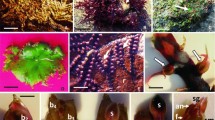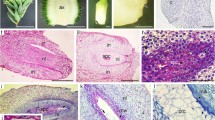Abstract
Fertilisation and proembryo development are described from transmission electron micrographs emphasising the origin and fate of the maternal and paternal mitochondria and plastids. During central cell and egg development mitochondria migrate toward the nuclei, forming a perinuclear zone consisting predominantly of maternal mitochondria and polysomes. At the same time, maternal plastids transformed and at fertilisation are excluded from the neocytoplasm. The pollen tube releases two sperm nuclei into the egg with cytoplasm from the generative cell and the tube cell. The leading sperm nucleus fuses with the egg nucleus and a small number of paternal mitochondria and plastids are taken into the perinuclear zone. The second sperm nucleus degenerates. As the zygote nucleus undergoes mitosis followed by free nuclear division and nuclear migration to the chalazal end of the archegonium, maternal and paternal organelles intermingle within the neocytoplasm. The result is paternal inheritance of plastids and biparental, but predominantly maternal, inheritance of mitochondria. This pattern is consistent within the Pinaceae but differs from some other conifer families.
Similar content being viewed by others
Author information
Authors and Affiliations
Additional information
Received: 9 December 1999 / Revision accepted: 30 April 2000
Rights and permissions
About this article
Cite this article
Bruns, D., Owens, J. Western white pine (Pinus monticola Dougl.) reproduction: II. Fertilisation and cytoplasmic inheritance. Sex Plant Reprod 13, 75–84 (2000). https://doi.org/10.1007/s004970000041
Issue Date:
DOI: https://doi.org/10.1007/s004970000041




